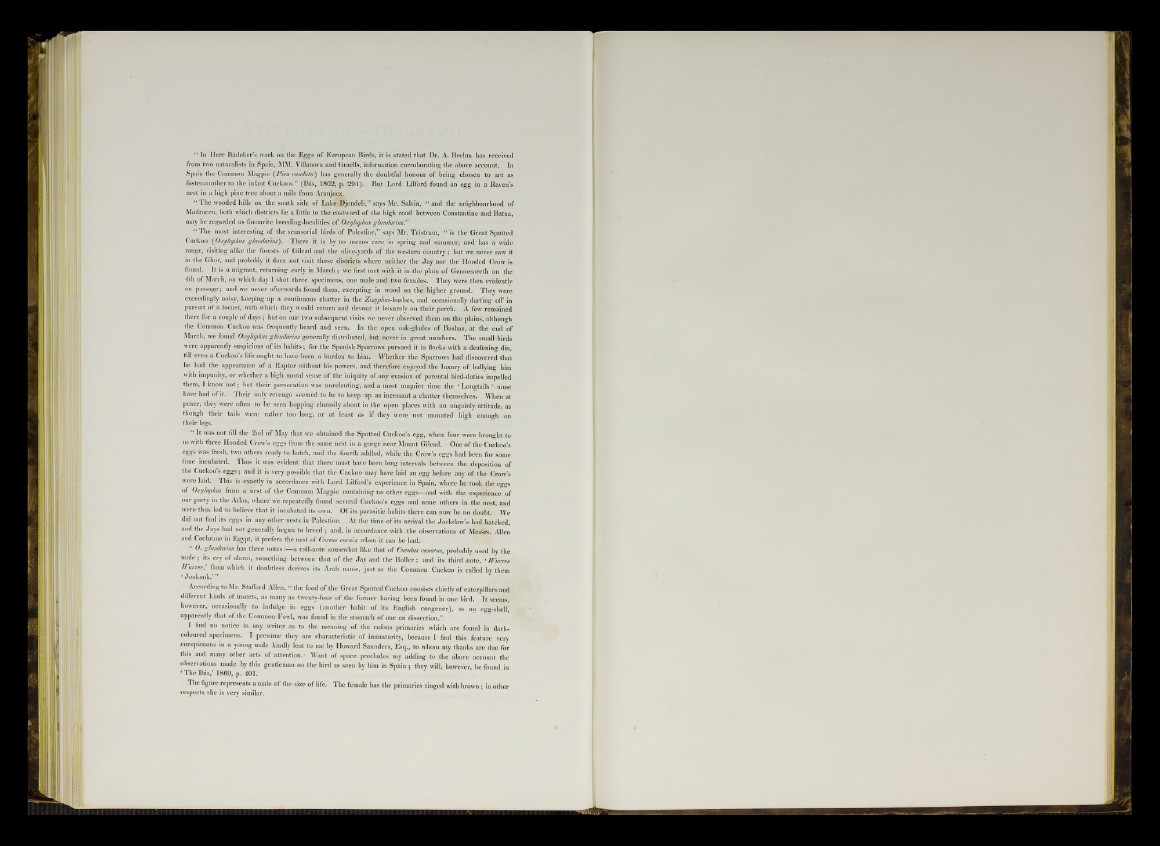
“ Iii Herr Badeker’s work 011 the Eggs of European Birds, it is stated that Dr. A. Brehm has received
from two naturalists in Spain, MM. Villanova and Graells, information corroborating the above account. In
Spain the Common Magpie ( Pica caudata) has generally the doubtful honour of being chosen to act as
foster-mother to the infant Cuckoos ” (Ibis, 1862, p. 294). But Lord Lilford found an egg in a Raven’s
nest in a high pine tree about a mile from Aranjuez.
“ The wooded hills on the south side of Lake Djendeli,” says Mr. Salvin, “ and the neighbourhood of
Madracen, both which districts lie a little to the eastward of the high road between Constantine and Batna,
may be regarded as favourite breeding-localities of Oxylophus glandarius.”
“ The most interesting of the scansorial birds of Palestine,” says Mr. Tristram, “'is the Great Spotted
Cuckoo ( Oxylophus glandarius'). There it is by no means rare in spring and summer, and has a wide
range, visiting alike the forests of Gilead and the olive-yards of the western country; but we never saw it
in the Ghor, and probably it does not visit those districts where neither the Jay nor the Hooded Crow is
found. It is a migrant, returning early in March; we first met with it in the plain of Gennesareth on the
4th of March, on which day I shot three specimens, one male and two females. They were then evidently
on passage; and we never afterwards found them, excepting in wood on the higher ground. They were
exceedingly noisy, keeping up a continuous chatter in the Zizyplus-bushes, and occasionally darting off in
pursuit of a locust, with which they would return and devour it leisurely on their perch. A few remained
there for a couple of days; but on our two subsequent visits we never observed them on the plains, although
the Common Cuckoo was frequently heard and seen. In the open oak-glades of Bashan, at the end of
March, we found Oxylophus glandarius generally distributed, but never in great numbers. The small birds
were apparently suspicious of its habits; for the Spanish Sparrows pursued it in flocks with a deafening din,
till even a Cuckoo’s life ought to have been a burden to him. Whether the Sparrows had discovered that
he had the appearance of a Raptor without his powers, and therefore enjoyed the luxury of bullying him
with impunity, or whether a high moral sense of the iniquity of any evasion of parental bird-duties impelled
them, I know not; but their persecution was unrelenting, and a most unquiet time the ‘ Longtails ’ must
have had of it. Their only revenge seemed to be to keep up as incessant a chatter themselves. When at
peace, they were often to be seen hopping clumsily about in the open places with an ungainly attitude, as
though their tails were rather too long, or at least as if they were not mounted high enough on
their legs.
1 ^ was tiN the 2nd of May that we obtained the Spotted Cuckoo’s egg, when four were brought to
us with three Hooded Crow’s eggs from the same nest ¡11 a gorge near Mount Gilead. One of the Cuckoo’s
eggs was fresh, two others ready to hatch, and the fourth addled, while the Crow’s eggs had been for some
time incubated. 1 ’hus it was evident that there must have been long intervals between the deposition of
the Cuckoo’s eggs; and it is very possible that the Cuckoo may have laid an egg before any of the Crow’s
were laid. This is exactly in accordance with Lord Lilford’s experience in Spain, where he took the eggs
of Oxylophus from a nest of the Common Magpie containing no other eggs—and with the experience of
our party in the Atlas, where we repeatedly found several Cuckoo’s eggs and none others in the nest, and
were thus led to believe that it incubated its own. Of its parasitic habits there can now be no doubt. We
did not find its eggs in any other nests in Palestine. At the time of its arrival the Jackdaw’s had hatched,
and the Jays had not generally begun to breed ; and, in accordance with the observations of Messrs. Allen
and Cochrane in Egypt, it prefers the nest of Corous cornix when it can be had.
“ 0. glandarius has three notes:—a call-note somewhat like that of Cuculus canorus, probably used by the
male; its cry of alarm, something between that of the Jay and the Roller; and its third note, ‘ Wurree
Wurree,’ from which it doubtless derives its Arab name, just as the Common Cuckoo is called by them
‘ Jookook.’ ”
According to Mr. Stafford Allen, “ the food of the Great Spotted Cuckoo consists chiefly of caterpillars and
different kinds of insects, as many as twenty-four of the former having been found in one bird. It seems,
however, occasionally to indulge in eggs (another habit of its English congener), as an egg-shell,
apparently that of the Common Fowl, was found in the stomach of one on dissection.”
I find no notice in any writer as to the meaning of the rufous primaries which are found in dark-
coloured specimens. I presume they are characteristic of immaturity, because I find this feature very
conspicuous in a young male kindly lent to me by Howard Saunders, Esq., to whom my thanks are due for
this and many other acts of attention.- Want of space precludes my adding to the above account the
observations made by this gentleman on the bird as seen by him in Spain ; they will, however, be found in
‘The Ibis,’ 1869, p. 401.
The figure represents a male of the size of life. The female has the primaries tinged with brown ; in other
respects she is very similar.